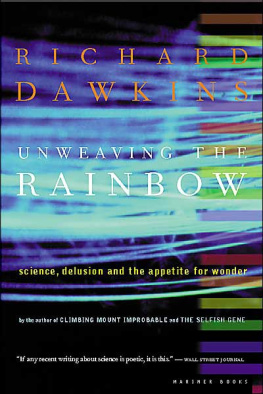Self - ADelusion?
by
Shelton Ranasinghe
Self A Delusion?
ISBN: 9781452489704
Copyright 2012, by Shelton Ranasinghe
2665 Devon Hill Road, Rocky River, Ohio 44116, USA
sr2665@gmail.com
2nd Edition
Published in United State of America.
All rights reserved. This book, or partsthereof, may not be reproduced in any form without permission fromthe author.
~
Many people believe we are more than mere neurons, but of coursewe are not.
We assume that we have free will and that itguides our decisions,
but its the Neurons in our brains that runus.
~
This book is dedicated to those neuronsthat put this book together.
~
Sincere thanks to my good friend BunchyRahuman for hearty support.
Self ADelusion?
Brain cells
I read an interesting article on the brainand consciousness at the website:
www.pbs.org/wgbh/nova/mind.
The article was titled The Electric Brainand it was presented as a dialogue between Dr. Llins (the authorof the article) and NOVA. It is well worth reading the fullversion, if its still available.
The article points out that the nervoussystem first came about when cells decided toevolve from plant life into animal life, millions of years ago.Animals needed a nervous system as they are oriented to a lifestyle where movement is inherent. The nervous system accommodatesthe movement, different environments and behavioral conditions. Dr.Llins explains that consciousness is the sum of perceptions of theconsensus derived by the cells when the cells started to talk toone another, a long time ago. He further states - We assume thatwe have free will and we make decisions, but we don't. Neurons inour brains do. We decide that this sum total driving us is adecision we have made for ourselves. But it is not.
He goes on;
The brain is made of cells. These are avery distinguished group of cells, about 550 million or more yearsold. These cells have a small mass. Our brain is aboutone-and-a-half liters, or three pounds, but it has 1010cells, which is a huge number, ten billion cells. And each cell(Neuron) has 1,000 to 10,000 of synapses that form the connectionsbetween the cells. So, the brain has trillions of synapses. Neuronslike one another very much. They respond to one another's messages,so they basically chat all day, like people do in society. "Wherecan I park?" "How much is it going to cost?" "Am I going to get aticket?" One set of neurons talks to another set of neurons, andthey talk back, so we have dialogues between different componentsin the brain. The dialogue is not between one cell and anothercell, but rather between many cells and many other cells. It's likehaving a huge number of people holding hands, dancing together,making ever-changing circles and organized together in such a waythat every cell belongs, at some time, to some circle. It's like ahuge square dance. Each dancer belongs to a particular movement ata particular time.
This article points out self as an operatingentity without a single commander. The collection of constantlychanging networks of tiny communication entities that keeps thelife operation running, gives the illusion of self.
After reading the above article I wasthinking of another documentary called K9 Conspiracy that I havewatched on television. This was about dogs. A crux of thedocumentary was to explain how this originally wild beast made useof the opportunities that it recognized during our ancestral hunterperiod. The movie very illustratively showed how the dogsmanipulated human beings to accept them initially and thengradually made their way up to the present realm of social statusthat they enjoy now. The hunting man adopted the dog because of theassociated benefits. The dogs were the first to realize the mutualbenefits of the connection and they responded wisely. Originallythe dogs were hanging around people, but at a distance. The dogswere not allowed inside the hunters' dwellings. They made themasters understand that they were guarding the dwellings by barkingat intruders and other potential threats in the night. The cuddlypuppies produced by the dogs, tempted the children of the mastersto play with them. Through the children, first the puppies and thenthe adult dogs gradually made their way into the houses. Over time,the lucky ones ended up on the beds with humans. The crafty schemeof achievement in their master plan seems to be still going on andseems to be operating exceptionally smoothly. Today dogs rendervery little service to the man, other than companionship. Really,the people have become slaves to the dogs now. People shower them,look after their health, give them nutritional food, allow them tosleep on their beds and even clean-up their messes. Even somePresidents of United States carry and comfort them in the WhiteHouse. If the very first dog that master minded this conspiracy wasliving today, I am pretty sure it would have a permanent canny grinon its face to reveal the success of its perfectly executed masterplan.
I think the dogs conspiracy story has adirect correlation to Dr. Llins concepts, with the cells takingover the place of the dogs. The Cells originated on the earthseveral millions of years ago. The Cells started multiplying andcreated primitive plants life. The Cells realized the importance ofworking as a group. The Cells also realized the importance ofcommunicating with each other. The Cells made necessary variationsto adjust to the environmental changes and various other needssurrounded them. At some stage the cells would have realized theimportance of introducing gender into the system for betterreproduction. This change made the cell conspirators able toproduce advanced life forms exactly as they desired.
All this clever work may have beenorchestrated by a complex network of smart cells. The complexnetwork of the communication system seems like an integral part ofthe cells master plan. Similar to the K9 conspiracy story, ifthere was a single cell, which masterminded the present live world,it would definitely have a cunning grin on its face to indicate thejoy of the success it achieved. Definitely, it would not only beaware of the past progress made but also will know the surprisesthat are in the pipeline for our future. When I wrote this passage,what came to my mind was a cartoon character of a cell seated incross legged style, relaxing on an easy chair at a beach wearingsunglasses, with a cigar in its mouth.
If you have followed Dr. Llins explanation,the ideas or actions that we generate are not controlled by aspecific cell but by several network-arrays of cells. In otherwords, we may be acting as slaves to the commands of the craftilyorganized army of billions of cells. We are the robots of the armyof cells that control us. These billions of cells, not only make usto act physically but pack us up with generic mental deliverables.The army of cells will not have a single commander but millions ofarrays of commander network cells as explained by Dr. Llins.
The social behavioral pattern of bees andants may help us understand the insight of this controllingconcepts better as there are a lot of similarities. In each beecolony there is a queen. The queens main function is to lay eggs.Other than the queen, there are drones and worker bees. All workerbees have different tasks to perform at various stages of theirlife span. The amazing fact is that the bees are not commanded byanybody, not even by the queen. Each bee is like a pre-programmedrobot. They function on network of communication systems that isnot governed by a commander. For example, if there is a threat tothe colony or to a single bee by an intruder, the alarm system isset to go off by releasing a particular chemical from their bodies.According to studies, once this chemical is sensed by the bees eachbee knows what to do in all types of situations. If the situationis to fight, then an assigned army of bees will fight. If the firstsquadron of army is losing the battle another set will join them.But strangely there is not a single commanding officer to summonthe second set of bees or to give commands at any stage of thebattle. It is an automated system. This behavioral pattern whichfunctions without a commander is amazing. These behavioral patternsdo exist with ants and other insects too. Though I cannot equate acell to a bee as the bees are made of millions of cells, thisleaderless operational phenomenon has a direct correlation to ourcomplex array of brain cell s networkingsystem described earlier. Probably the consciousness of our cellsand the decision-making cell networks of could be operating in asimilar manner, in our life operation. If this phenomenon isrealistic, then there is no single commander that we can consideras self.
Next page






